Our group is capable of providing design solutions to Landslide Remedies, Foundation improvement & Rehabilitation issues.
Landslide is movement process which may be translational or rotational mass move over a stable subsoil. Movements are occurring along clear (defined failure plane), and sometimes unclear (complex failure due to joint effects) slip surface. Mass moving down the slope can be slow or can be very quickly and devastating depending upon numerous triggering factors.
Types of landslides
Landslides are very diverse phenomena in shape and size, movement speed and other characteristics. According to geological structural feature in which landslides occur, we can distinguish instability in soil and rock mass.
In soil/highly disintegrated rock mass we distinguish the following types of instability:
- Rotational landslide (Slope comprising similar material layer properties)
- Translational landslide (One occurs along a distinctive weakness surface features such as a fault, joint or bedding plane)
- Debris flow (intense saturated sand/silt sized particles, occur on steep slopes )
- Debris avalanche (rapid movement of debris)
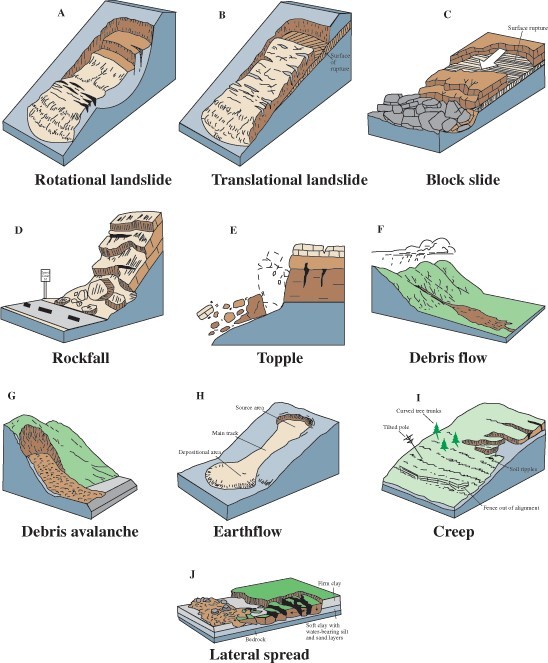
- Earthflow (extreme mud content with intense saturation)
- Creep (deformation occur due to slow movement, shear stress is between failure and deformation)
- Lateral spread (due to rapid ground motion leading to liquefaction of saturated fine grained soils on gentle terrain)
- Block slide
- Rock fall
- Topple
Landslide causes
There are two categories of landslide causes: natural and human causes. Sometimes landslide occurs in combination of both.
- Natural causes include geological factors like weathered, jointed, fissured material and morphological factors like erosion of slope, deposition on slope, freezing thawing
- Human factors like loading in the slope, excavation of toe of slope, uncontrolled blasting, and deforestation.
Mitigation techniques
Mitigation techniques used to continue stabilizing, controlling and preventing landslides are:
Hydrogeological Methods
(a) Control of Surface drainage
- Ditches to prevent surface flows from entering the slide
- Grading of slide to drain the surface and prevent ponding
- Placing impermeable layer over the slope Controlling Subsurface drainage
- Underdrains and trenches
- Network of Horizontal and Vertical drains
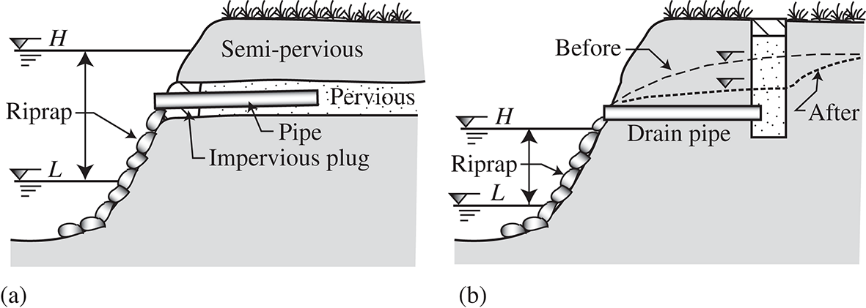
Mechanical Methods
- Increase resisting forces
- Retaining walls.
- Reinforced earth.
- Vegetation and soil bioengineering.
- Soil reinforcement (soil nails, anchorage system).
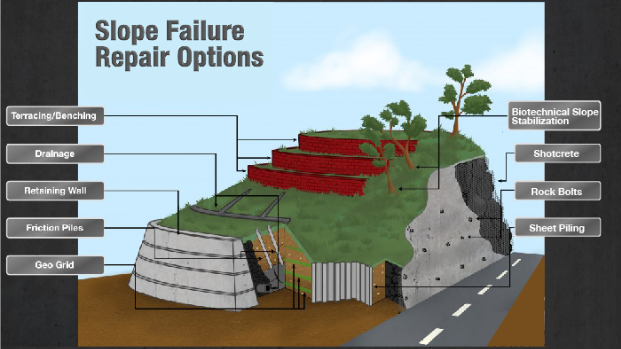
- Passive Prestressed Cable Anchor to address global stability.
- Self-Drilling Anchors for sliding protection (Advantage over Driven Soil Nail due its providing more stiffness from surrounding grout).
- Micropiles (To control Lateral Movement of Slope).
- Tied Back wall at bottom of slope
Protection against Rockfalls
- Meshing arrangement for surficial protection
- Rock fall protection barriers/Nets.
- Debris flow barrier.
- Latest Developed Flexible sheds for Railways to protection against shooting stones.
Reduce driving forces
- Removal of top (head) of slide mass.
- Backfilling a portion of slide mass with lightweight fill.
Chemical Methods
Using various methods of grouting techniques. Use of grout technique depends upon type of problem encountered like seepage problem having cracks in joints or silt-clay strata permeation grouting, other type of grouting like jet grouting can be used depending upon type of problem.
Foundation remediation and rehabilitation
If requested by the client for foundation remediation purpose, containing at least the following:
Investigation
- Scope of services, observations, site characteristics, and data deemed pertinent by the engineer.
- Discussion of major factors influencing foundation performance and rationale in reaching conclusions concerning the subject residence.
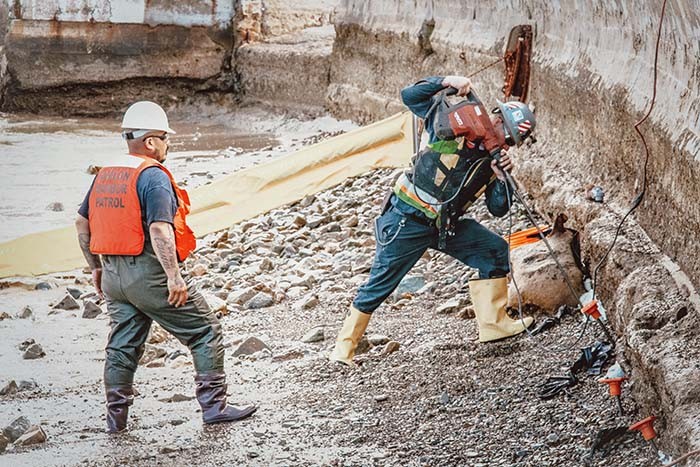
- Conclusions and any recommendations for further investigation and remedial or preventative measures.
- Determination of relative foundation elevations in sufficient detail to represent the shape of the foundation and drawing showing relative elevations
- The additional services, testing and related reports deemed appropriate by the Engineer. These may include, but are not limited to, the following: 1. Site specific soil sampling and testing 2. Drainage system testing 3. Material testing 4. Steel reinforcing survey.
- This level of investigation should also include a more detailed level of reporting, which may include the following: 1. Scaled drawings 2. Description of factors that affect soil moisture 3. Observations of cut and fill 4. Photographs 5. Detailed distress survey.
Evaluation and Methodology
A rational method should be used to establish causes of distress or diminished performance, if any. A suggested method is summarized as follows:
- Observe the structure, site conditions, other relevant phenomena, and collect pertinent data.
- Analyse the data and Formulate hypotheses.
- Test the hypotheses using analyses acceptable to the engineering profession along with engineering experience.
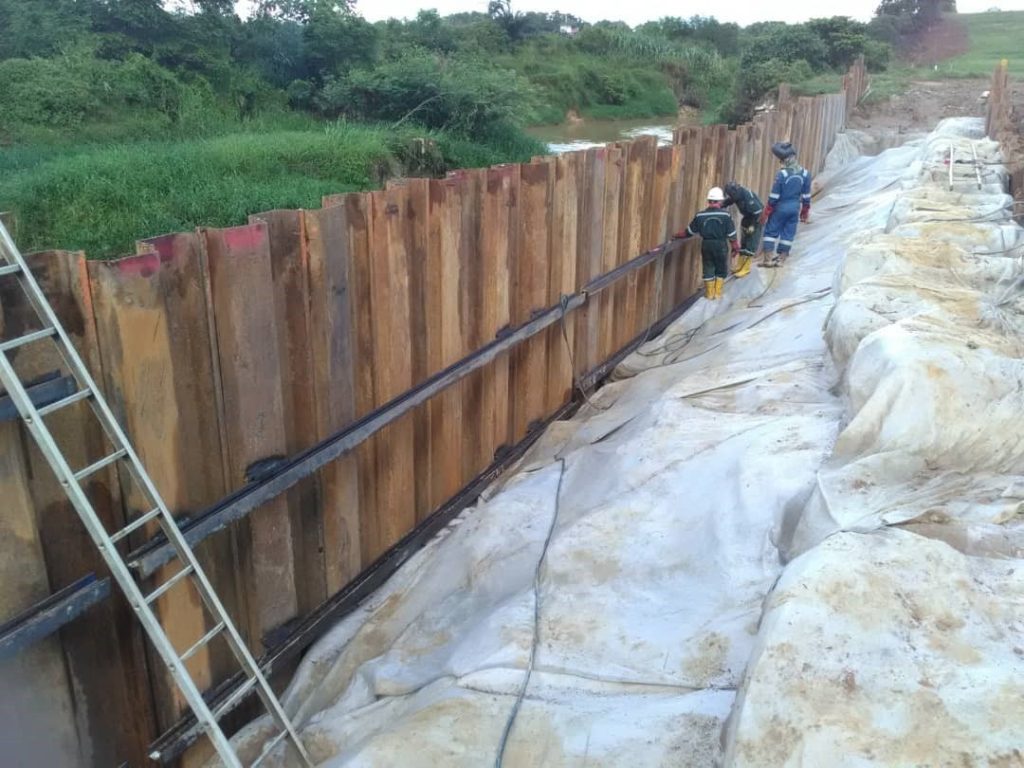
- Reach conclusions or reformulate the hypotheses.
- Various Foundation rehabilitation methods include depending upon type of problem, Micropiles for underpinning, Micropile with tie back for deep foundation protection system, Sheet pile if light structure is there and foundation problem on clay soil. Many more options are available which varies site to site.